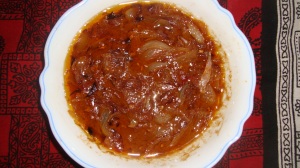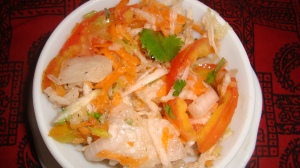May this special day of Wesak, which celebrates the day of birth, enlightenment and death of Buddha, bring you peace!

Blue water-lily – the national flower of Sri Lanka
I am sharing this post on Angie’s challenge for this month with my recipe for turmeric coriander bread filled with seeni sambol. Ever since I started baking last year, I have found that I enjoy baking different types of bread. One of my favourite and successful breads is rosemary olive oil bread (recipe source: Jessie@A Hint of Honey). Using her recipe as a base, I have sometimes played around with herbs to make different versions of the bread and today, I would like to share my Sri Lankan twist to this bread.
Turmeric Coriander Bread with Seeni Sambol
Ingredients:
- Flour – 2 to 2 ½ cups, approximately
- Turmeric – 1 tsp
- Coriander – 2 to 4 tbsp fresh coriander leaves (as per your taste) or 1 tsp dried powder
- Pepper – pinch
- Salt – ½ tsp
- Sesame/ Gingelly oil – 2 tbsp
- Warm water – 1 cup
- Sugar – 1 tbsp
- Yeast – 2 tsp
- Seeni Sambol – recipe provided in this post
Method:
- Stir in 1 tbsp sugar and 2 tsp yeast in 1 cup of warm water in a mixing bowl and let it sit for about 10 mins till it becomes frothy.
- Sift the flour and set aside.
- Add a cup of flour to the yeast mixture and add the salt, turmeric, pepper, chopped coriander or powder to the mixing bowl.
- Mix well before adding the sesame oil and add the remaining flour ¼ cup at a time till the dough is formed. Knead for a few minutes till it is smooth.
- Lightly dab the mixing bowl with a little oil and cover, leaving the dough to rise for about an hour.
- Transfer the dough to a floured surface and roll out the dough.
- Spread the seeni sambol mixture over the surface. Starting from one end, roll the dough into a log.
- You could leave the dough as a log or connect the ends to make a round bread or cut into 8 equal pieces. If you cut into 8 pieces, make each piece into a ball ensuring that the ends are closed and that the filling is not seeping out of the dough.
- Transfer the dough to a lightly greased baking tray. Cover and refrigerate till about 30 minutes before you plan to bake.
- Leave the tray out in the kitchen for about 30 minutes before brushing the bread with either a little melted margarine or dissolved sugar.
- Bake the bread at 175⁰C/340⁰F for 20 mins. Check at intervals as the baking time differs depending on the oven.
- Serve warm with a nice vegetable soup.





